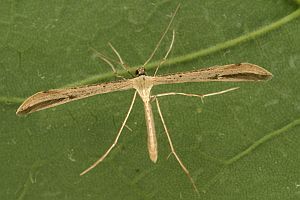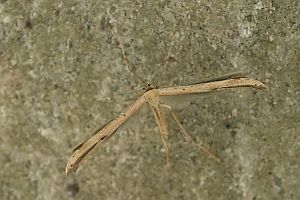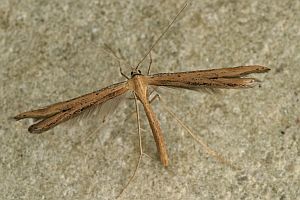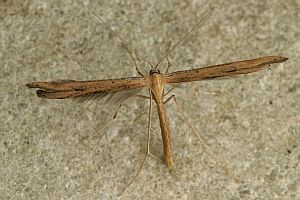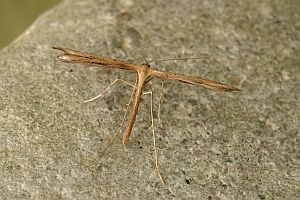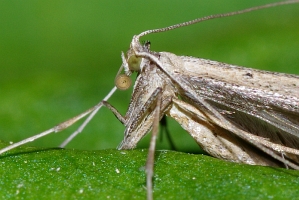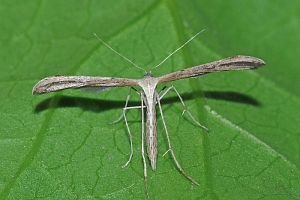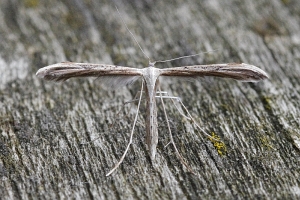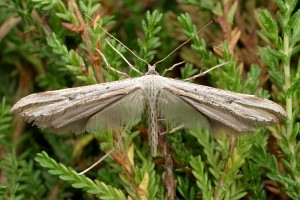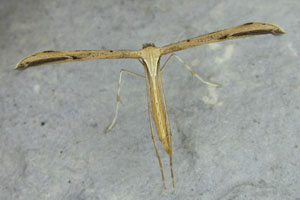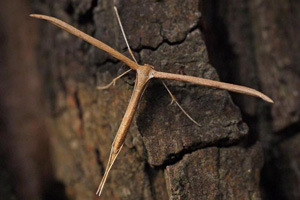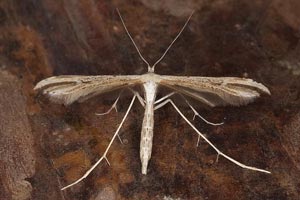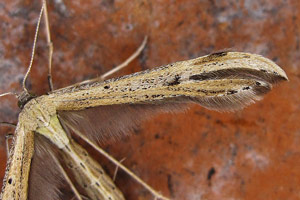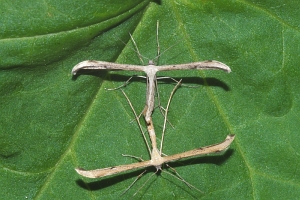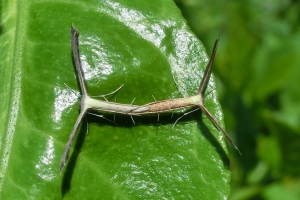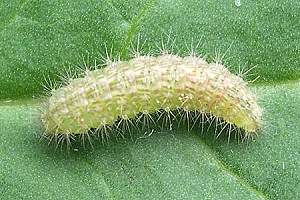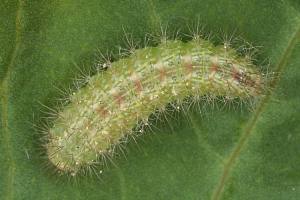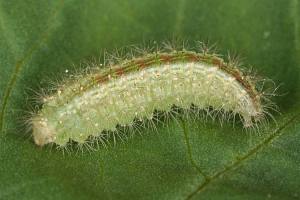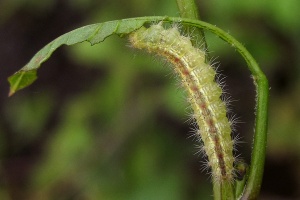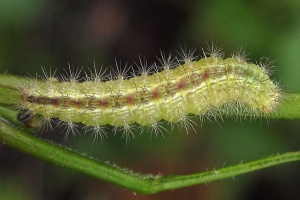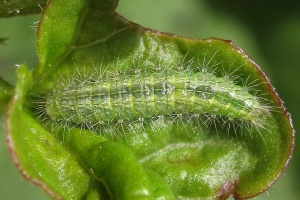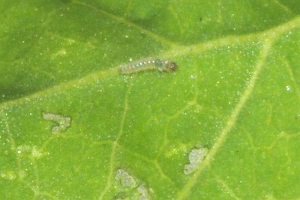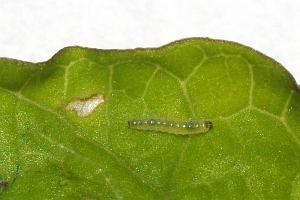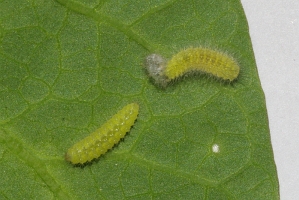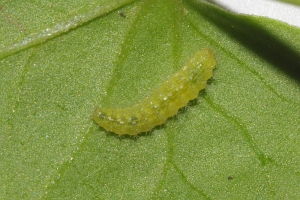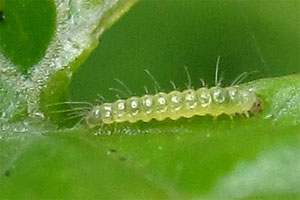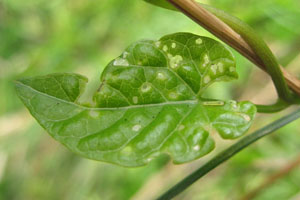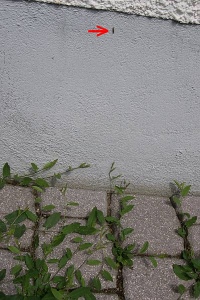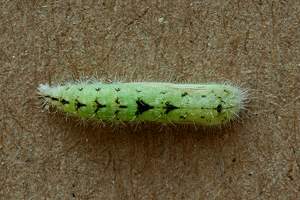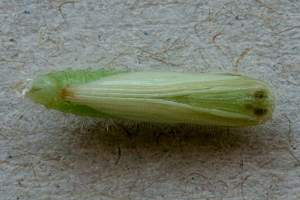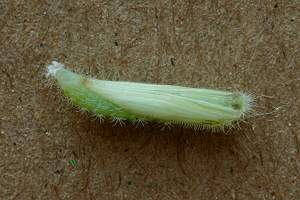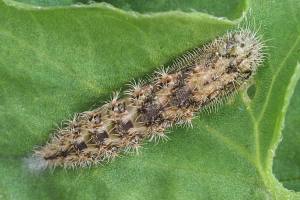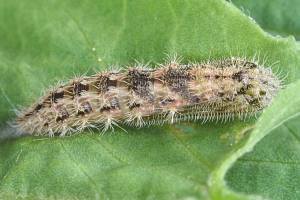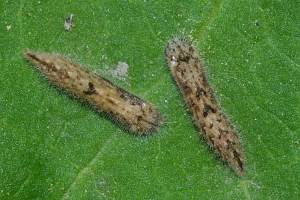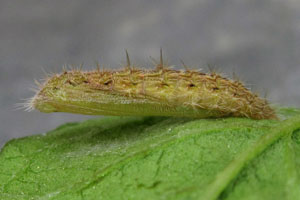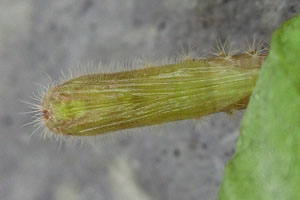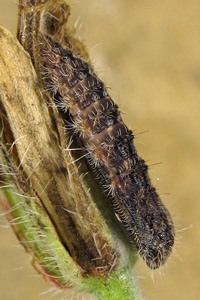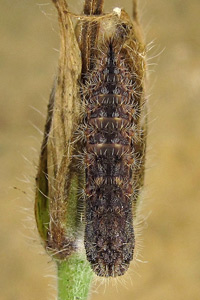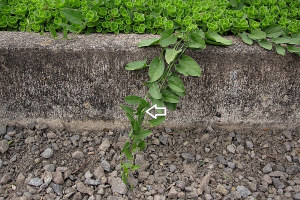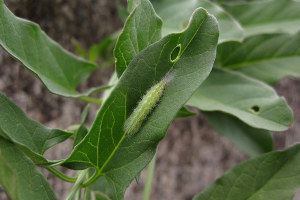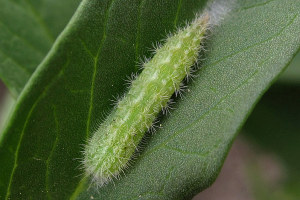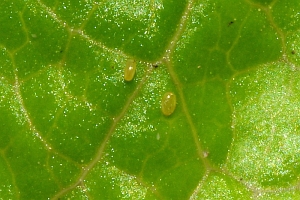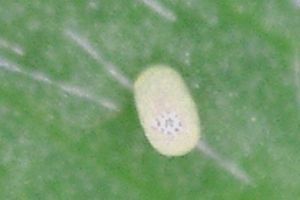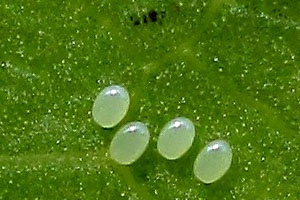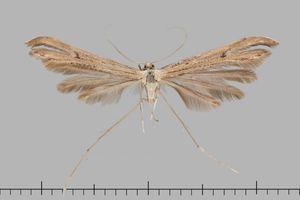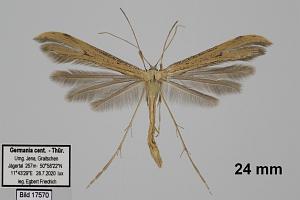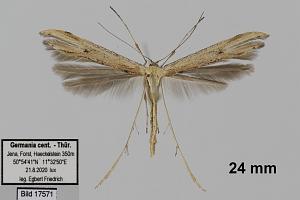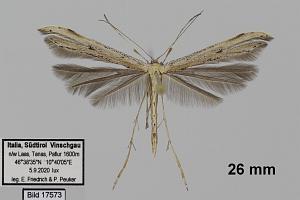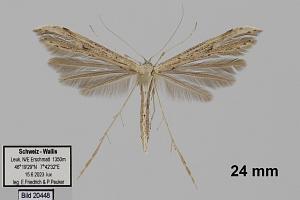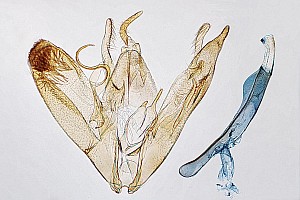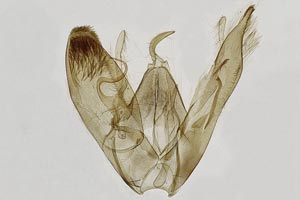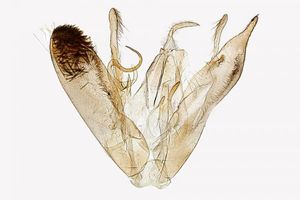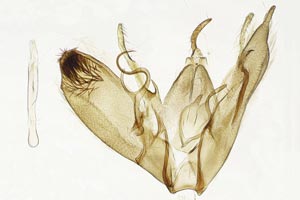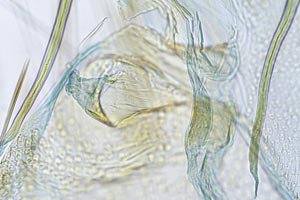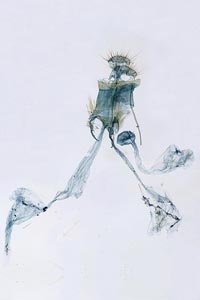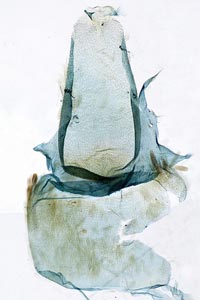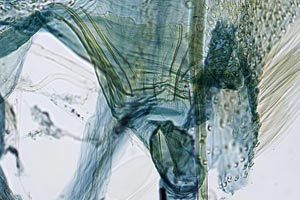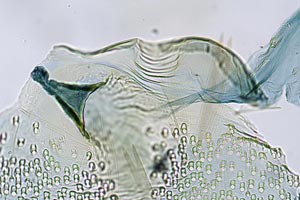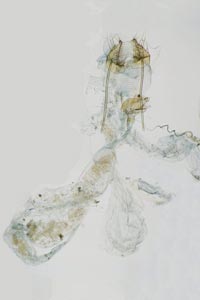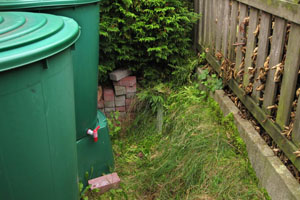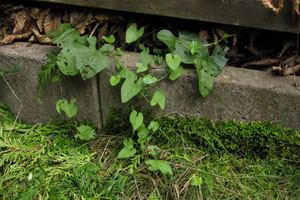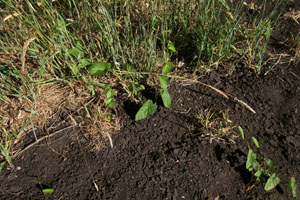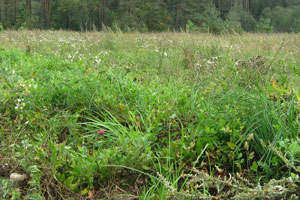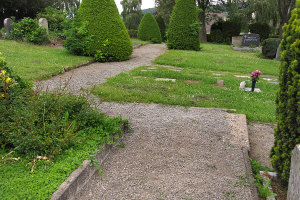
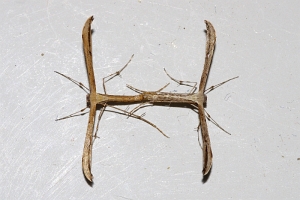
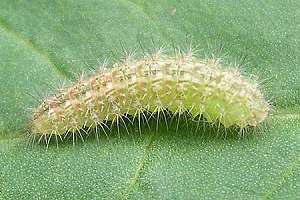

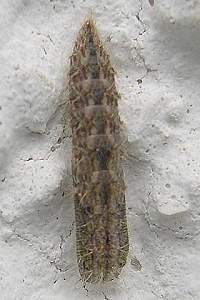
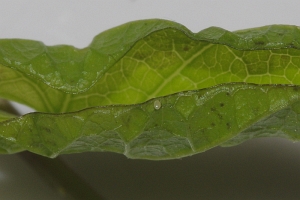
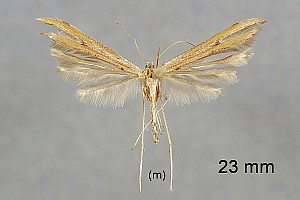
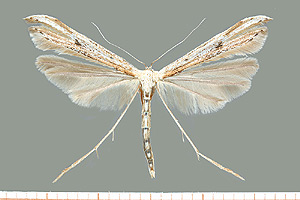
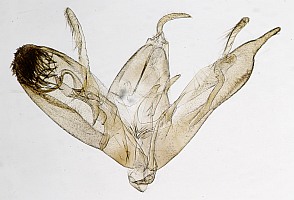
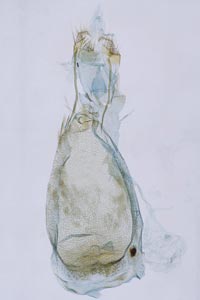

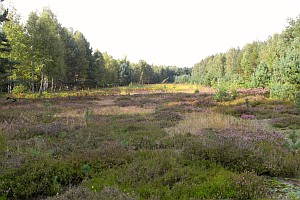
1. Lebendfotos
1.1. Falter
1.2. Kopula
1.3. Ausgewachsene Raupe
1.4. Jüngere Raupenstadien
1.5. Puppe
1.6. Ei
2. Diagnose
Von der viel selteneren Emmelina argoteles nur durch Genitaluntersuchung zu unterscheiden. Text: Rudolf Bryner
2.1. Männchen
2.2. Weibchen
2.3. Genitalien
2.3.1. Männchen
2.3.2. Weibchen
2.4. Erstbeschreibung
3. Biologie
3.1. Habitat
3.2. Nahrung der Raupe
- [Convolvulaceae:] Convolvulus arvensis (Acker-Winde)
- [Convolvulaceae:] Convolvulus floridus (Blütenreiche Winde)
- [Convolvulaceae:] Convolvulus prostratus ? [= Convolvulus pluricaulis, Convolvulus microphyllus ?] (Kleinblütige Winde ?)
- [Convolvulaceae:] Convolvulus cantabrica ? (Kantabrische Winde ?)
- [Convolvulaceae:] Convolvulus althaeoides ? (Eibischblättrige Winde ?)
- [Convolvulaceae:] Calystegia sepium [= Convolvulus sepium] (Echte Zaunwinde)
- [Convolvulaceae:] Calystegia soldanella (Strandwinde)
- [Convolvulaceae:] Calystegia spithamaea ?
- [Convolvulaceae:] Calystegia subacaulis ? [= Convolvulus subacaulis ?]
- [Convolvulaceae:] Ipomoea batatas ? (Batate, Süßkartoffel ?)
- [Convolvulaceae:] Ipomoea purpurea ? [= Ipomoea hispida ?] (Purpur-Prunkwinde ?)
Die Raupe lebt in Mitteleuropa an Acker- oder Zaunwinden. Die Meldung zu Calystegia soldanella geht auf einen Raupenfund von Nel (1989: 476) auf Korsika zurück. Toth et al. (2003) bestätigen, dass die Raupe an sehr unterschiedlichen Standorten an Convolvulus arvensis gefunden werden kann, dass es aber fast keine Schadmeldungen an der zur gleichen Familie gehörenden Batate (Ipomoea batatas) gibt. Angaben zu Chenopodium oder Atriplex dürften auf Fehlbestimmung der Raupen beruhen, Angaben zu Senecio, Matricaria und Calluna vulgaris sind zweifellos falsch.
Arenberger & Baez (2011: 84) melden die Art von Teneriffa von Convolvulus floridus, einem Kanaren-Endemiten.
Fazekas & Edmunds (2023: 28, 30) trugen zusammen: "Larvae polyphagous, recorded on Convolvulus arvensis, C. microphyllus, C. cantabrica, C. althaeoides, C. floridus, C. subacaulis, Calystegia soldanella, C. sepium, C. spithamaea, Chenopodium spp., Atriplex spp., Ipomoea purpurea, I. batatas, I. hispida, I. niger and Datura stramonium. It favours typical host plant habitats such as dry grasslands, roadsides, weedy areas, forest edges, scrub edges, rocky grasslands, steppe slopes, as well as semi-arid and wet habitats, groves, and agricultural and kitchen gardens." - was mit "Ipomoea niger" gemeint ist, weiß ich nicht. Chenopodium, Atriplex und auch Datura stramonium bleiben sicher falsch. Die genannten Convolvulaceae sind plausibel - nur ist nicht immer sicher, ob die Raupen und die Pflanzen richtig bestimmt waren.
(Autor: Erwin Rennwald)
3.3. Phänologie
Die frühere Auffassung, dass Imagines von Emmelina monodactyla das ganze Jahr über gefunden werden können, während Emmelina argoteles in zwei Generationen von April bis Juni und August bis September fliegt, ist überholt. Nach [FAZEKAS (2015)] überwintern auch bei Emmelina argoteles die Imago, womit bei Winterfunden beide Arten möglich wären. Siehe dazu auch [Daniel Bartsch im Forum].
4. Weitere Informationen
4.1. Andere Kombinationen
- Alucita monodactyla Linnaeus, 1758 [Originalkombination]
4.2. Synonyme
- Phalaena bidactyla Hochenwarth, 1785
- Emmelina albodactyla (Fabricius, 1794)
- Pterophorus cineridactylus Fitch, 1854
- Pterophorus naevosidactylus Fitch, 1854
- Pterophorus impersonalis Walker, 1864
- Pterophorus pergracilidactylus Packard, 1873
- Pterophorus barberi Dyar, 1903
- Pterophorus pictipennis Grinnell, 1908
4.3. Faunistik
Barberis & Nel (2023) melden die in Europa weit verbreitete Art erstmals von der Insel Pantelleria.
Fazekas & Edmunds (2023: 28, 30) melden die Art von Kreta und fassen den Kenntnisstand zusammen: "A wide-ranging species, mainly known from the western Palaearctic. In the south, it is found in North Africa and Saudi Arabia. It is found in southern Siberia and central Asia, as well as in China and northern India. Elsewhere, it occurs in the Nearctic, in Canada and U.S.A, in Neotropical Venezuela and Mexico in Afrotropical Kenya (Gielis, 2003), in Oriental India and the Philippines. Probably an introduced species outside the Palaearctic."
(Autor: Erwin Rennwald)
4.4. Literatur
- Arenberger, E. & M. Baez (2011): Die Pterophoridae (Lepidoptera) des Kanarischen Archipels. — Zeitschrift der Arbeitsgemeinschaft ÖsterreichischerEntomologen, 63: 81-99. [PDF auf zobodat.at]
- Barberis, P. & J. Nel (2023): Contribution à la connaissance des microlépidoptères de l'île de Pantelleria (Italie) avec description d'Anomalotinea cossyrella sp.n. (Tineidae) (Insecta, Lepidoptera). — Revue de l'Association Roussillonnaise d'Entomologie, 32 (3): 219-223.
- Fazekas, I. & H. Edmunds (2023): New records of Alucitidae and Pterophoridae species from Crete (Lepidoptera). — Lepidopterologica Hungarica, 19 (1): 25–36. [PDF auf researchgate.net]
- Erstbeschreibung: Linnaeus, C. (1758): Systema naturae per regna tria naturae, secundum classes, ordines, genera, species, cum characteribus, differentiis, synonymis, locis. Tomus I. Editio decima, reformata. 1-824. Holmiae (Laurentius Salvius).
- Lectotypus-Festlegung: Robinson, G. S. & E. Schmidt Nielsen (1983): The Microlepidoptera described by Linnaeus and Clerck. — Systematic Entomology 8: 191-242.
- [SCHÜTZE (1931): 161-162]
- Tóth, P., Tóthová, M. & L. Cagáň (2003): Emmelina monodactyla (Linnaeus, 1758)(Lepidoptera: Pterophoridae), its parasitization and potential as a biological control agent of Field or Lesser Bindweed (Convolvulus arvensis L.). — Entomologist's Gazette, 54: 233-241. [PDF auf researchgate.net]



![Vorkommen in Österreich [Huemer (2013: NR 2150)]](/res/img/flag/at.png)

![Vorkommen in Island [Aarvik & al. (2017): Nordic-Baltic Checklist]](/res/img/flag/is.gif)
![Vorkommen in Norwegen (außer Spitzbergen und Jan Mayen) [Aarvik & al. (2017): Nordic-Baltic Checklist]](/res/img/flag/no.gif)
![Vorkommen in Dänemark (außer Färöer-Inseln und Grönland) [Aarvik & al. (2017): Nordic-Baltic Checklist]](/res/img/flag/dk.gif)

![Vorkommen in Schweden [Aarvik & al. (2017): Nordic-Baltic Checklist]](/res/img/flag/se.gif)
![Vorkommen in Finnland (außer Åland-Inseln) [Aarvik & al. (2017): Nordic-Baltic Checklist]](/res/img/flag/fi.gif)
![Vorkommen in Russland (europäischer Teil bis Manytsch-Niederung) [Kozlov, Kullberg & Zverev (2014)]](/res/img/flag/ru.gif)
![Vorkommen in der Ukraine (ohne Halbinsel Krim) [Demyanenko, Bidzilya & Karolinskiy (2021)]](/res/img/flag/ua.gif)
![Vorkommen auf der Krim [Sinev (2021)]](/res/img/flag/ua-kri.gif)
![Vorkommen in Weißrussland [Pisanenko, A., Švitra, G. & V. Piskunov (2019): Checklist of Lepidoptera recorded from Belarus]](/res/img/flag/by.gif)
![Vorkommen in Estland [Aarvik & al. (2017): Nordic-Baltic Checklist]](/res/img/flag/ee.gif)
![Vorkommen in Lettland [Aarvik & al. (2017): Nordic-Baltic Checklist]](/res/img/flag/lv.gif)
![Vorkommen in Litauen [Aarvik & al. (2017): Nordic-Baltic Checklist]](/res/img/flag/lt.gif)
![Vorkommen in Polen [Buszko J. & J. Nowacki [eds] (2017): A Distributional Checklist of the Lepidoptera of Poland]](/res/img/flag/pl.gif)
![Vorkommen in Tschechien [Laštůvka, Z. & J. Liška (2011): Komentovaný seznam motýlů České republiky]](/res/img/flag/cz.gif)

![Vorkommen in Ungarn [Pastorális et. al. (2018): A Magyarországon előforduló molylepke-fajok névjegyzéke]](/res/img/flag/hu.gif)
![Vorkommen in Großbritannien [Agassiz, Beavan & Heckford (2013): Checklist of the Lepidoptera of the British Isles]](/res/img/flag/gb.gif)
![Vorkommen in Irland einschließlich Nordirland [Bond & O'Connor (2012): Checklist of Irish Species]](/res/img/flag/ie.gif)
![Vorkommen in Belgien [De Prins(2016): Catalogus van de Belgische Lepidoptera]](/res/img/flag/be.gif)
![Vorkommen in den Niederlanden [Kuchlein & de Vos (1999): Annotated Checklist of the Dutch Lepidoptera]](/res/img/flag/nl.gif)
![Vorkommen in Luxemburg [Wagner-Rollinger, C. (1972); Hellers (2022b)]](/res/img/flag/lu.gif)
![Vorkommen in Frankreich (europäisches Territorium ohne Korsika) [Vandromme et al. (2020): Liste systématique et taxinomique des Lépidoptères de France]](/res/img/flag/fr.gif)
![Vorkommen auf Korsika [Brusseaux, G. & J. Nel (2004)]](/res/img/flag/fr-cor.png)
![Vorkommen in Monaco [Lemaire & Billi (2018)]](/res/img/flag/mc.gif)
![Vorkommen in Andorra [Dantart (2015)]](/res/img/flag/ad.gif)
![Vorkommen in Spanien (Festland) [Vives Moreno A. (2014)]](/res/img/flag/es.gif)
![Vorkommen auf den Kanarischen Inseln [Vives Moreno, A. (2014)]](/res/img/flag/es-cn.png)
![Vorkommen auf den Balearischen Inseln (Spanien) [Vives Moreno A. (2014)]](/res/img/flag/es-ib.gif)
![Vorkommen in Portugal (Festland) [Corley (2015): Lepidoptera of Continental Portugal]](/res/img/flag/pt.gif)
![Vorkommen auf Madeira [Aguiar & Karsholt (2006)]](/res/img/flag/pt-ma.png)
![Vorkommen auf den Azoren [Vieira & Karsholt (2010)]](/res/img/flag/pt-az.png)
![Vorkommen in Italien (Festland und kleine festlandsnahe Inseln) [Arenberger et al. (1995): Checklist delle Specie della Fauna Italiana 86]](/res/img/flag/it.gif)
![Vorkommen auf Sardinien [Arenberger et al. (1995): Checklist delle Specie della Fauna Italiana 86]](/res/img/flag/it-sar.png)
![Vorkommen in Sizilien [Arenberger et al. (1995): Checklist delle Specie della Fauna Italiana 86]](/res/img/flag/it-sic.png)
![Vorkommen in Malta [Sammut (1984)]](/res/img/flag/mt.gif)
![Vorkommen in Slowenien [Lesar & Govedič (2010): Check list of Slovenian Microlepidoptera]](/res/img/flag/si.gif)
![Vorkommen in Kroatien [Koren (2018); Gumhalter, Berggren & Aarvik (2023)]](/res/img/flag/hr.gif)
![Vorkommen in Bosnien und Herzegowina [Rebel (1904): Lepidopterenfauna der Balkanländer]](/res/img/flag/ba.gif)
![Vorkommen in Serbien [Jakšić (2016): Tentative Checklist of Serbian microlepidoptera]](/res/img/flag/rs.gif)
![Vorkommen in Nordmazedonien [Klimesch, J. (1968)]](/res/img/flag/mk.gif)
![Vorkommen in Rumänien [Rákosy L. & M. Goia (2021): Lepidopterle din România: lista sistematică şi distribuţie]](/res/img/flag/ro.gif)
![Vorkommen in Bulgarien [Beshkov & Langourov (2004)]](/res/img/flag/bg.gif)
![Vorkommen in Griechenland (Festland und festlandsnahe Inseln) [Huemer & Mutanen (2022)]](/res/img/flag/gr.png)
![Vorkommen auf Kreta [Nel & Nel (2003); Fazekas & Edmunds (2023)]](/res/img/flag/gr.gif)
![Vorkommen im europäischen Teil der Türkei [Koçak & Kemal (2018)]](/res/img/flag/tr.gif)
![Vorkommen in Georgien [Nedoshivina, Ustjuzhanin, Kovtunovich, Streltzov & Yakovlev (2023)]](/res/img/flag/ge.gif)
![Vorkommen in Iran [Rajaei & al. (2023)]](/res/img/flag/ir.gif)
![Vorkommen in Israel [Ustjuzhanin, Kovtunovich, Kravchenko, Saldaitis, Müller & Weinstein (2020)]](/res/img/flag/il.gif)
![Vorkommen in China [Fazekas & Edmunds (2023)]](/res/img/flag/cn.gif)
![Vorkommen in Indien (Festland) [Fazekas & Edmunds (2023): im Norden]](/res/img/flag/in.gif)
![Vorkommen auf den Philippinen [Fazekas & Edmunds (2023): wohl aus der Palaearktis verschleppt]](/res/img/flag/ph.gif)
![Vorkommen in Indonesien [wohl aus der Palaearktis verschleppt]](/res/img/flag/id.gif)
![Vorkommen in Kenia [Fazekas & Edmunds (2023): wohl aus der Palaearktis verschleppt]](/res/img/flag/ke.gif)
![Vorkommen in den Vereinigten Staaten von Amerika (USA) [Fazekas & Edmunds (2023): wohl aus der Palaearktis verschleppt]](/res/img/flag/us.gif)
![Vorkommen in Kanada [Fazekas & Edmunds (2023): wohl aus der Palaearktis verschleppt]](/res/img/flag/ca.gif)
![Vorkommen in Mexiko [Fazekas & Edmunds (2023): wohl aus der Palaearktis verschleppt]](/res/img/flag/mx.gif)
![Vorkommen in Venezuela [Fazekas & Edmunds (2023): wohl aus der Palaearktis verschleppt]](/res/img/flag/ve.gif)

